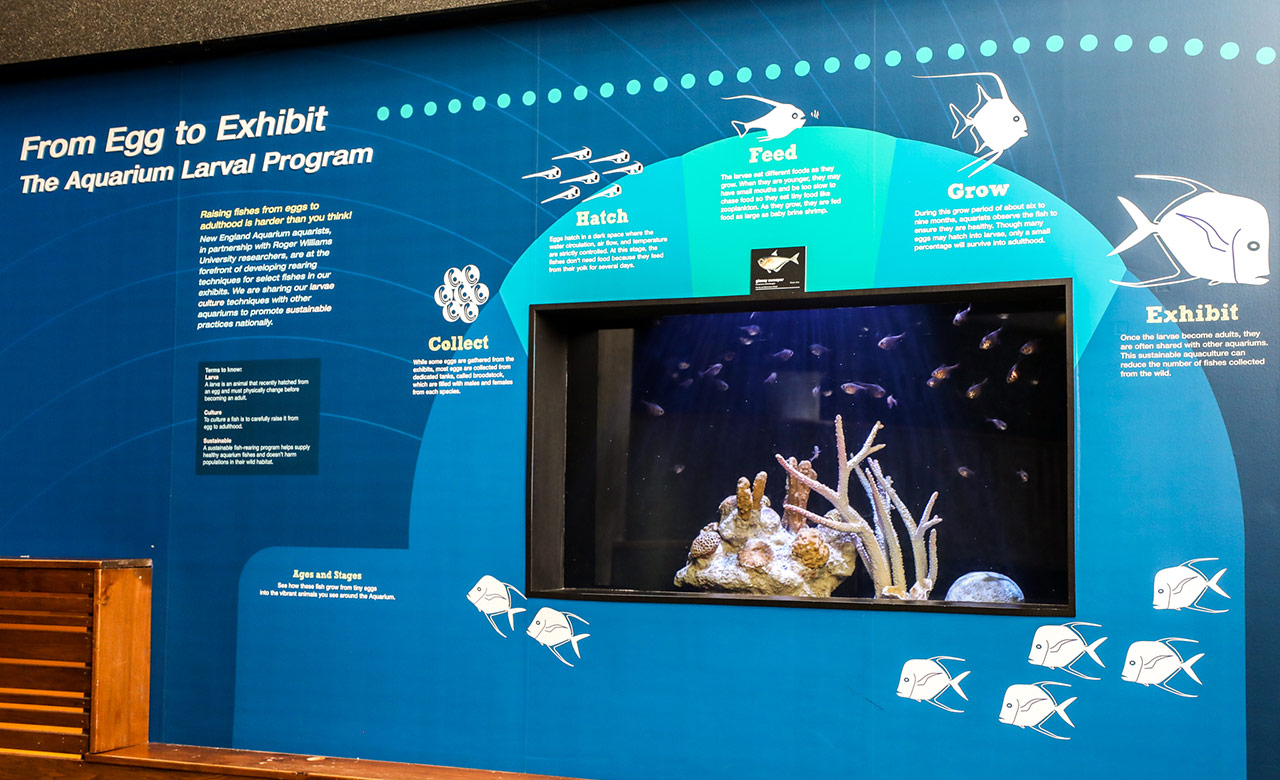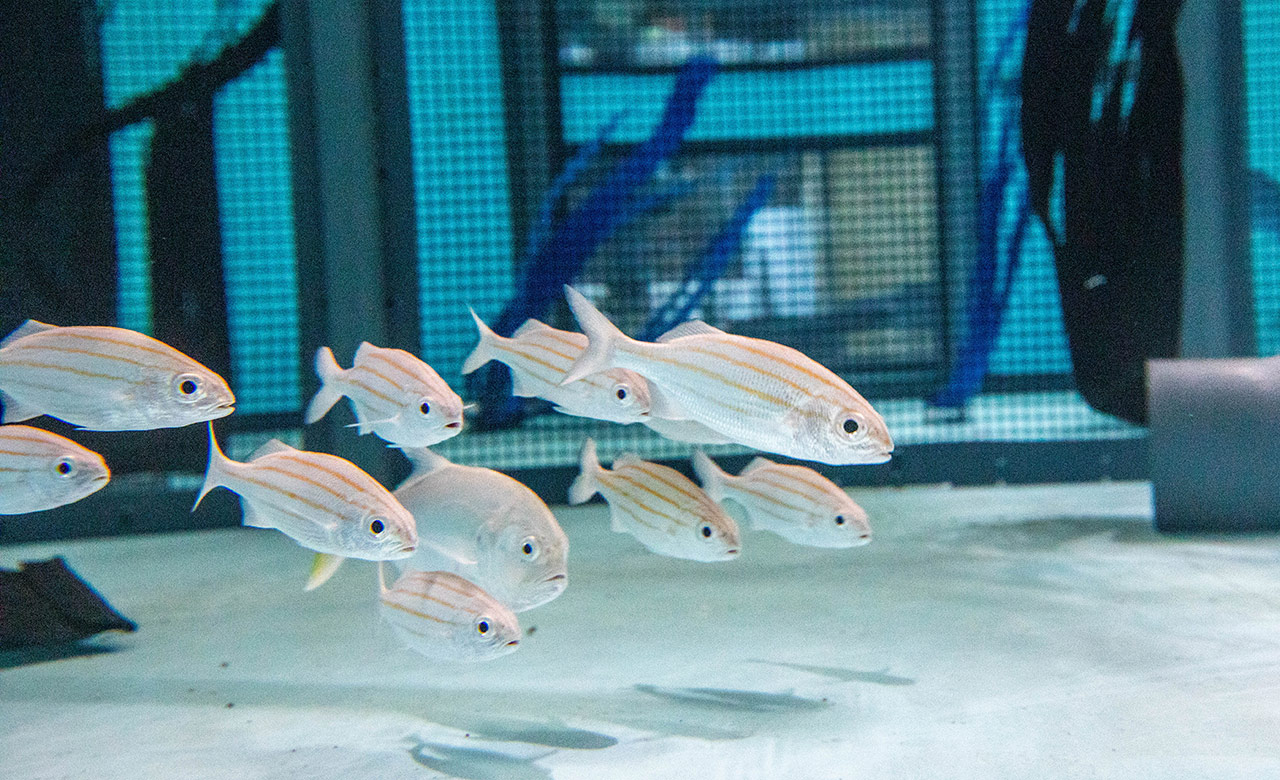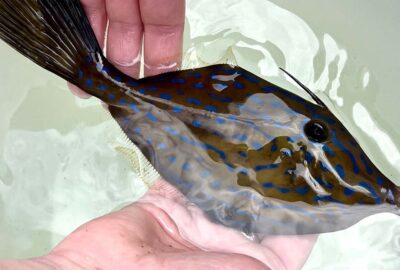Raising Fish, Growing Knowledge
Our sustainable breeding program has raised 15 fish species from eggs to adults—and discovered countless insights along the way.


Since 2008, the New England Aquarium has partnered with Roger Williams University to build a sustainable aquaculture program, collecting fish eggs and rearing them to adults in-house. The goal of the program is to reduce impacts on wild populations and improve animal wellbeing.
At the Aquarium’s Animal Care Center in Quincy, the team has successfully reared 15 species in the program, including lookdowns, smallmouth grunts, glassy sweepers, blue chromis, and brown chromis. Five of the species had never been cultivated in an aquaculture setting before.
Many of these fish find a permanent home in the Giant Ocean Tank, the Aquarium’s largest exhibit, once they’ve grown enough.
“The New England Aquarium has aquacultured 63 percent of our Giant Ocean Tank, so it makes a big impact,” said Monika Schmück, manager of sustainability. “And the schools of lookdowns and smallmouth grunts are really dynamic.”
A Collaborative Approach
In recent years, the sustainable breeding program has expanded through partnerships within the Association of Zoos and Aquariums (AZA), a nonprofit dedicated to advancing zoos’ and aquariums’ efforts in conservation, education, science, and recreation. In the AZA Aquatic Collections Sustainability Committee’s collaborative model, organizations commit to raising specific species based on their expertise and the committee’s goals. They share the aquacultured fish and their findings about how to raise them. This year, the Aquarium will be rearing lookdowns, smallmouth grunts, glassy sweepers, and creole wrasse—a new species for the team.
“It’s like community-supported agriculture,” said Barbara Bailey, vice president of Animal Care at the Aquarium. “We pool our resources, our knowledge, and our experience into one big group so that we can share with the greater community.”
This collaboration is essential to advancing aquaculture because many fish species are delicate. Discovering best practices for rearing them requires lots of patience, persistence, and scientific trial and error.
“We’re really the innovators learning about what happens when these fish hatch,” Barbara said. “Success is measured by how much further we get from the previous attempt.”
/
Scientific Discovery and Documentation
When the team collects eggs from the broodstock (parents), they record data on the quantity and quality of the eggs. Over time, aquarists learn through patterns that appear in the data. For example, were there more or fewer eggs during different phases of the moon cycle? Were the eggs of a higher quality when the broodstock diet was changed?
As the eggs hatch, the tiny fish get moved to small tubs. There, the fish are closely monitored as they grow. Aquarists systematically adjust variables like diet, light, water flow, and temperature and are careful to change only one variable at a time to isolate the cause of any impacts on the larval fish.
During this process, the team can’t assume anything. When raising queen triggerfish early in the sustainable breeding program, the team naturally increased the size of the food as the fish grew, only to discover under a microscope later that the size of the fish’s mouths actually shrank as they grew! Unlike most species, they needed smaller food over time.
Documentation is critical throughout the entire process so aquarists can refer back to past learnings and stay consistent no matter who is caring for the fish on a given day. The goal is to gather enough information to create a rearing protocol for the species. The team has also developed a Marine Fish Egg Catalog, with pictures and key information about over 100 species’ eggs so public aquariums can identify eggs, potentially as a first step of raising them in-house.
In-house Insights with Ocean Applications
Another benefit of raising fish in-house is gaining insights about the species. When aquarists know exactly what day fish were born, they can learn about the animal’s growth curve and longevity. Lookdowns and smallmouth grunts grow to about an inch long within 60 days, while glassy sweepers take about three months to reach the same size, for instance.
“Because we’re able to study them so closely, we’re learning so much more about these fish than we would if we didn’t have that opportunity,” Barbara said.
Learnings discovered in-house can be applied to help ocean populations too.
“You could use information about rearing them and how they breed to conserve them in the wild,” Monika said. “That information is really helpful in understanding how their eggs and larvae are dispersed in the ocean and what they look for in terms of breeding sites.”
As environmental pressures make it increasingly difficult to find fish in the wild, aquaculture programs are more important than ever. The Aquarium hopes to continue expanding its capacity and knowledge to support exhibits on Central Wharf—as well as partner aquariums and marine life around the world—so these animals can become ambassadors for their species, inspiring millions of visitors each year.
This story originally appeared in the Spring 2025 issue of blue member magazine.






